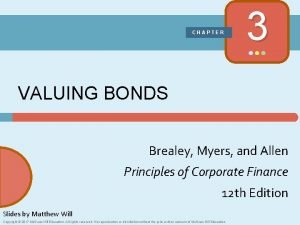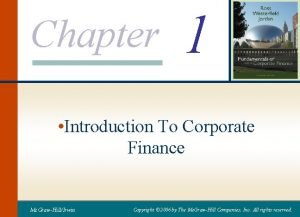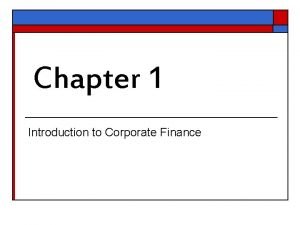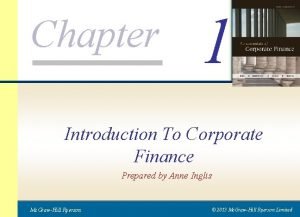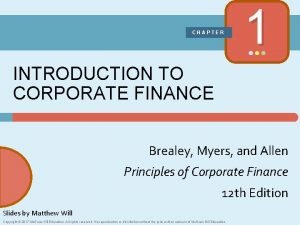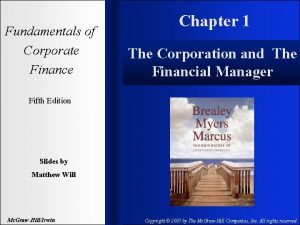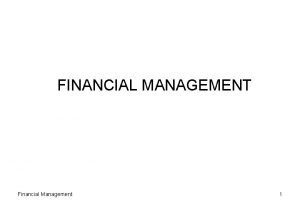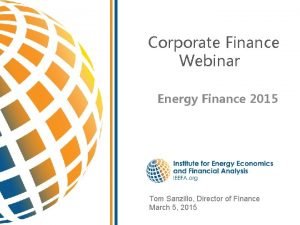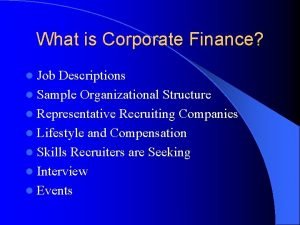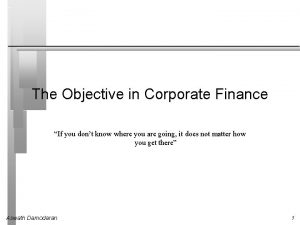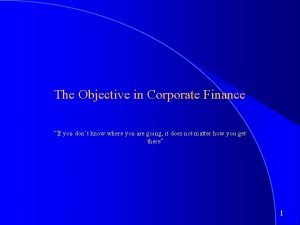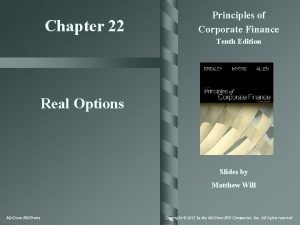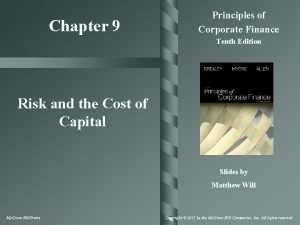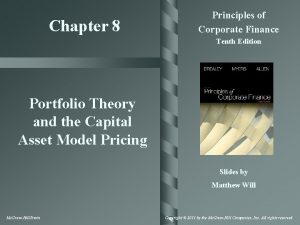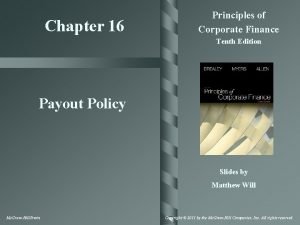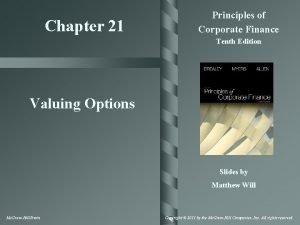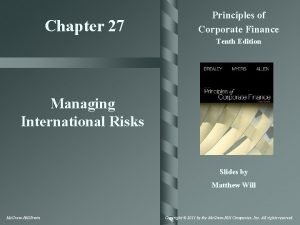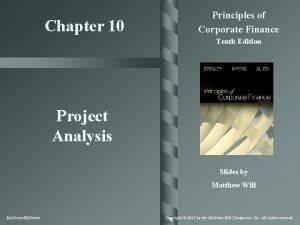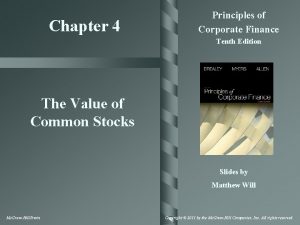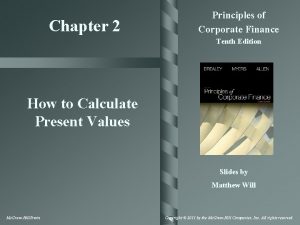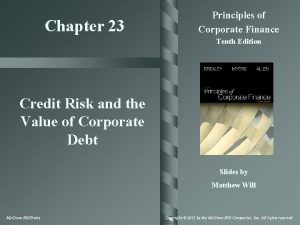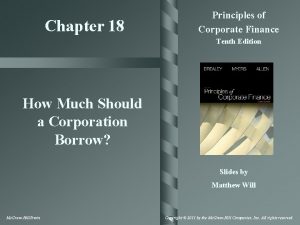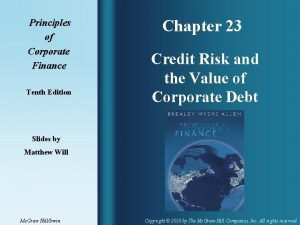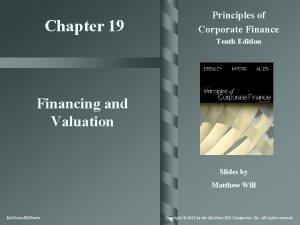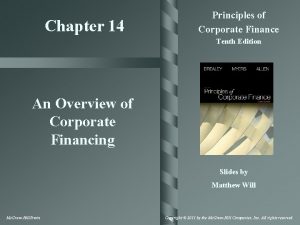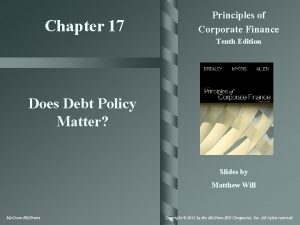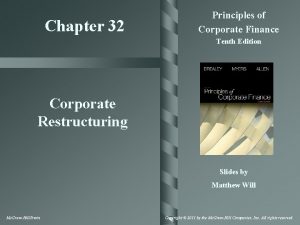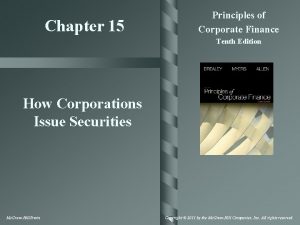Chapter 7 Principles of Corporate Finance Tenth Edition




































- Slides: 36

Chapter 7 Principles of Corporate Finance Tenth Edition Introduction to Risk and Return Slides by Matthew Will Mc. Graw-Hill/Irwin Copyright © 2011 by the Mc. Graw-Hill Companies, Inc. All rights reserved.

Topics Covered Ø Over a Century of Capital Market History Ø Measuring Portfolio Risk Ø Calculating Portfolio Risk Ø How Individual Securities Affect Portfolio Risk Ø Diversification & Value Additivity 7 -2

The Value of an Investment of $1 in 1900 7 -3

The Value of an Investment of $1 in 1900 Real Returns 7 -4

Average Market Risk Premia (by country) Risk premium, % Country 7 -5

0. 00 2005 2000 1995 1990 1985 1980 1975 1970 1965 1960 1955 1950 1945 1940 1935 1930 1925 1920 1915 1910 1905 1900 Dividend Yield (%) Dividend Yield 7 -6 Dividend yields in the U. S. A. 1900– 2008 10. 00 9. 00 8. 00 7. 00 6. 00 5. 00 4. 00 3. 00 2. 00 1. 00

Rates of Return 1900 -2008 Stock Market Index Returns Percentage Return 80. 0 60. 0 40. 0 20. 0 -20. 0 -40. 0 -60. 0 Source: Ibbotson Associates Year 7 -7

7 -8 Measuring Risk Histogram of Annual Stock Market Returns (1900 -2008) # of Years Return %

Measuring Risk Variance - Average value of squared deviations from mean. A measure of volatility. Standard Deviation - Average value of squared deviations from mean. A measure of volatility. 7 -9

Measuring Risk Coin Toss Game-calculating variance and standard deviation 7 -10

Measuring Risk 7 -11

Standard Deviation of Annual Returns, % Equity Market Risk (by country) Average Risk (1900 -2008) 7 -12

Dow Jones Risk Annualized Standard Deviation of the DJIA over the preceding 52 weeks Standard Deviation (%) (1900 – 2008) 70 60 50 40 30 20 10 0 Years 7 -13

Measuring Risk Diversification - Strategy designed to reduce risk by spreading the portfolio across many investments. Unique Risk - Risk factors affecting only that firm. Also called “diversifiable risk. ” Market Risk - Economy-wide sources of risk that affect the overall stock market. Also called “systematic risk. ” 7 -14

Comparing Returns 7 -15

Measuring Risk 7 -16

Measuring Risk 7 -17

Portfolio Risk The variance of a two stock portfolio is the sum of these four boxes 7 -18

Portfolio Risk Example Suppose you invest 60% of your portfolio in Campbell Soup and 40% in Boeing. The expected dollar return on your Campbell Soup stock is 3. 1% and on Boeing is 9. 5%. The expected return on your portfolio is: 7 -19

Portfolio Risk Example Suppose you invest 60% of your portfolio in Campbell Soup and 40% in Boeing. The expected dollar return on your Campbell Soup stock is 3. 1% and on Boeing is 9. 5%. The standard deviation of their annualized daily returns are 15. 8% and 23. 7%, respectively. Assume a correlation coefficient of 1. 0 and calculate the portfolio variance. 7 -20

Portfolio Risk Example Suppose you invest 60% of your portfolio in Campbell Soup and 40% in Boeing. The expected dollar return on your Campbell Soup stock is 3. 1% and on Boeing is 9. 5%. The standard deviation of their annualized daily returns are 15. 8% and 23. 7%, respectively. Assume a correlation coefficient of 1. 0 and calculate the portfolio variance. 7 -21

Portfolio Risk Another Example Suppose you invest 60% of your portfolio in Exxon Mobil and 40% in Coca Cola. The expected dollar return on your Exxon Mobil stock is 10% and on Coca Cola is 15%. The expected return on your portfolio is: 7 -22

Portfolio Risk Another Example Suppose you invest 60% of your portfolio in Exxon Mobil and 40% in Coca Cola. The expected dollar return on your Exxon Mobil stock is 10% and on Coca Cola is 15%. The standard deviation of their annualized daily returns are 18. 2% and 27. 3%, respectively. Assume a correlation coefficient of 1. 0 and calculate the portfolio variance. 7 -23

Portfolio Risk Another Example Suppose you invest 60% of your portfolio in Exxon Mobil and 40% in Coca Cola. The expected dollar return on your Exxon Mobil stock is 10% and on Coca Cola is 15%. The standard deviation of their annualized daily returns are 18. 2% and 27. 3%, respectively. Assume a correlation coefficient of 1. 0 and calculate the portfolio variance. 7 -24

Portfolio Risk 7 -25

Portfolio Risk Example Stocks ABC Corp Big Corp s 28 42 Correlation Coefficient =. 4 % of Portfolio Avg Return 60% 15% 40% 21% Standard Deviation = weighted avg = 33. 6 Standard Deviation = Portfolio = 28. 1 Real Standard Deviation: = (282)(. 62) + (422)(. 42) + 2(. 4)(. 6)(28)(42)(. 4) = 28. 1 CORRECT Return : r = (15%)(. 60) + (21%)(. 4) = 17. 4% 7 -26

Portfolio Risk Example Stocks ABC Corp Big Corp s 28 42 Correlation Coefficient =. 4 % of Portfolio Avg Return 60% 15% 40% 21% Standard Deviation = weighted avg = 33. 6 Standard Deviation = Portfolio = 28. 1 Return = weighted avg = Portfolio = 17. 4% Let’s Add stock New Corp to the portfolio 7 -27

7 -28 Portfolio Risk Example Stocks Portfolio New Corp Correlation Coefficient =. 3 s % of Portfolio 28. 1 50% 30 50% NEW Standard Deviation = weighted avg = 31. 80 NEW Standard Deviation = Portfolio = 23. 43 NEW Return = weighted avg = Portfolio = 18. 20% NOTE: Higher return & Lower risk How did we do that? DIVERSIFICATION Avg Return 17. 4% 19%

7 -29 Portfolio Risk The shaded boxes contain variance terms; the remainder contain covariance terms. 1 2 3 STOCK To calculate portfolio variance add up the boxes 4 5 6 N 1 2 3 4 5 6 STOCK N

Portfolio Risk Market Portfolio - Portfolio of all assets in the economy. In practice a broad stock market index, such as the S&P Composite, is used to represent the market. Beta - Sensitivity of a stock’s return to the return on the market portfolio. 7 -30

Portfolio Risk The return on Dell stock changes on average by 1. 41% for each additional 1% change in the market return. Beta is therefore 1. 41. 7 -31

Portfolio Risk The middle line shows that a well Diversified portfolio of randomly selected stocks ends up with 1 and a standard deviation equal to the market’s—in this case 20%. The upper line shows that a well-diversified portfolio with 1. 5 has a standard deviation of about 30%— 1. 5 times that of the market. The lower line shows that a well-diversified portfolio with. 5 has a standard deviation of about 10%—half that of the market. 7 -32

Portfolio Risk 7 -33

Portfolio Risk Covariance with the market Variance of the market 7 -34

Beta 7 -35

Web Resources Click to access web sites Internet connection required www. globalfindata. com http: //www. gacetafinanciera. com/TEORIARIESGO/MPS. pdf 7 -36
 Corporate finance tenth edition
Corporate finance tenth edition Corporate finance tenth edition
Corporate finance tenth edition Corporate finance tenth edition
Corporate finance tenth edition Corporate finance tenth edition
Corporate finance tenth edition Corporate finance tenth edition
Corporate finance tenth edition Principles of corporate finance chapter 3 solutions
Principles of corporate finance chapter 3 solutions Goal of corporate finance
Goal of corporate finance Fundamentals of corporate finance, third canadian edition
Fundamentals of corporate finance, third canadian edition Fundamentals of corporate finance canadian edition
Fundamentals of corporate finance canadian edition Fundamentals of corporate finance fifth edition
Fundamentals of corporate finance fifth edition Corporate finance 6th edition
Corporate finance 6th edition Campbell biology tenth edition
Campbell biology tenth edition Campbell biology tenth edition
Campbell biology tenth edition Campbell biology tenth edition
Campbell biology tenth edition Elementary statistics tenth edition
Elementary statistics tenth edition Digital fundamentals floyd
Digital fundamentals floyd Psychology tenth edition david g myers
Psychology tenth edition david g myers Introduction to genetic analysis tenth edition
Introduction to genetic analysis tenth edition Biology tenth edition
Biology tenth edition The graph shows data from the light colored soil
The graph shows data from the light colored soil Cloroplastos
Cloroplastos Biology tenth edition
Biology tenth edition Principles of corporate finance
Principles of corporate finance Fundamentals of corporate finance chapter 6 solutions
Fundamentals of corporate finance chapter 6 solutions Introduction to corporate finance
Introduction to corporate finance Fundamentals of corporate finance chapter 1
Fundamentals of corporate finance chapter 1 Chapter 1 introduction to corporate finance
Chapter 1 introduction to corporate finance Chapter 1 introduction to corporate finance
Chapter 1 introduction to corporate finance Chapter 1 introduction to corporate finance
Chapter 1 introduction to corporate finance Fundamentals of corporate finance, chapter 1
Fundamentals of corporate finance, chapter 1 Tenth chapter wired
Tenth chapter wired Financial management theory
Financial management theory Tom sanzillo
Tom sanzillo Corporate finance vs investment banking
Corporate finance vs investment banking Corporate finance job scope
Corporate finance job scope Objective of corporate finance
Objective of corporate finance Objectives of corporate finance
Objectives of corporate finance





